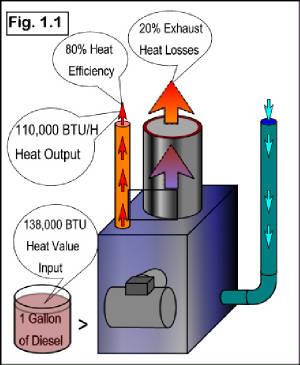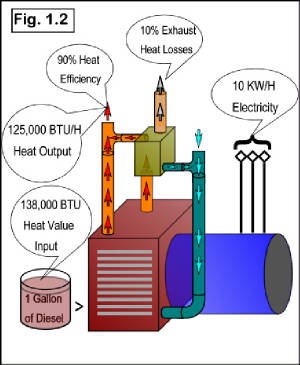|

The Boiler
The common hot water heating boiler shown in Figure 1.1 has the
capacity to heat a 1,000 square foot home with average heat losses against an outside temperature of minus 30 degrees Celsius.
With an input of 138,000 Btu per hour and an 80% conversion efficiency,
the output then is 110,000 BTU in useable “House Heat”, with 28,000 BTU attributed to “Exhaust Heat Losses”.
The net heating value in one gallon of fuel when used in this
system would be 110,000 BTU. And could heat an average house for about five hours at -30 Celsius,
... but also requiring that there be an external source
of electricity (Hydro Grid) available to run the burner and circulating pump.

The "Heat" Generator
In contrast, when the heating fuel energy is released in a motor
(Fig 1.2), it not only allows for more efficient heat recovery from the cooling system and exhaust but also makes use of the
motors’ torque energy to turn an electrical generator, through which it doubles the usable energy output, resulting
in additional and completely free electricity.
Making use of nearly all of the available energy in a gallon of
home heating oil/diesel fuel, results in;
- 90% Heat Extraction Efficiency @ 125,000 BTU in “Home
Heat Output”,
- 10% Exhaust Heat Losses @ 13,800 BTU.
- Plus *10KW/H of free electricity*.
Now a gallon of fuel would not only heat two houses, one on recovered
heat, the other one on electricity, and for six to seven hours against the same (-30 C) winter conditions outside, BUT
also generate sufficient electricity for minor appliance use and house lighting for both of them,
...PLUS .... do all of this…….
……..completely independent of a Public
Power Supply…..…….
|
